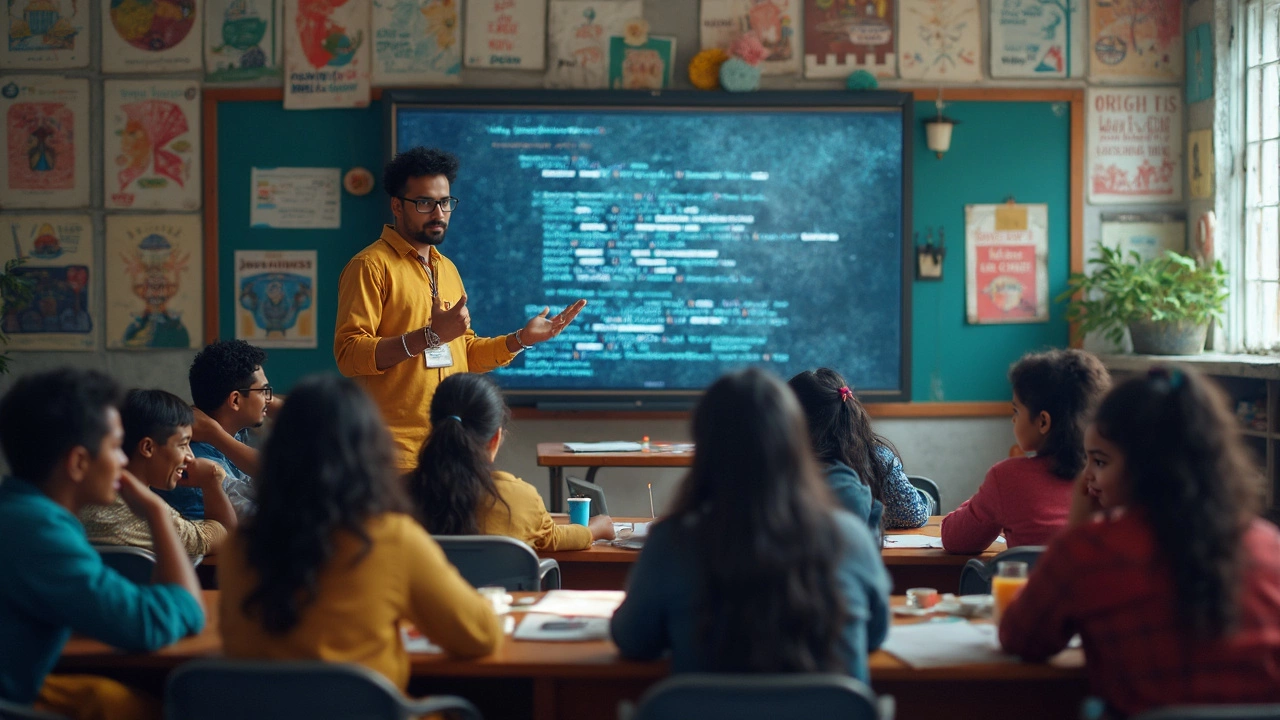Dipping your toes into coding and unsure where to begin? Let's make it as simple as possible. Many people assume coding is all about complex algorithms and endless lines of text. Sure, it gets to that point, but not initially.
For beginners, simplicity is key. Starting with an easy-to-learn language not only boosts confidence but also lays a solid foundation to tackle more complicated concepts later. So, which language should you choose first?
How about JavaScript? It's all about making your web browser work smarter, allowing you to add interactivity to web pages. Then there's Python, which has a super-friendly syntax making it look almost like plain English. It's a favorite for many beginners out there.
- Why Start with Simple Code?
- JavaScript: Your Browser's Best Friend
- Python: Code Like a Pro
- HTML/CSS: Building Blocks of the Web
- Scratch: Fun with Code
- Tips to Kickstart Your Coding Adventure
Why Start with Simple Code?
Diving into the world of coding can feel a bit overwhelming at first. People often think coding is this massive mountain of complexity. But really, it doesn't have to be. Starting with simple coding languages can make your journey way smoother.
Ever tried learning to swim by jumping straight into the deep end? Probably not the best idea, right? The same logic applies here. By choosing the easiest programming languages that match your learning style, you lower the barrier to entry and save yourself from unnecessary frustration.
Python and JavaScript are often the go-to choices for beginners. Why? Python's syntax is clean and readable, which means less time stuck on annoying syntax errors. With JavaScript, you can see results instantly in a web browser – a pretty neat way to keep your motivation up.
Build Confidence First
When you start with a beginner coding language, you build your confidence. Every little program you create feels like a victory, and it doesn't go unnoticed. Confidence keeps you excited, and let's face it, a motivated learner picks up skills way faster.
Master the Basics
Starting simple means more time to truly understand the core concepts, like loops, variables, and functions. These basics are the backbone of almost every language out there, and once you've nailed them in a beginner coding language, transitioning to tougher languages becomes less intimidating.
- HTML/CSS: Perfect for those interested in web design.
- Scratch: Ideal for younger beginners wanting to have fun while coding.
Ultimately, starting simple isn't just about taking an easier path. It's about setting yourself up for long-term success in the coding world. With patience, practice, and the right language, you'll soon be ready to tackle more advanced challenges with confidence.
JavaScript: Your Browser's Best Friend
JavaScript is like that friend who's always there. It's practically on every corner of the web. When you click a button on a website and something cool happens, that's JavaScript working behind the scenes. It's the go-to for adding interactive elements to websites, making it a must-learn for newcomers.
One of the coolest things about JavaScript is that it's supported by all modern web browsers. You don't need any fancy tools to start learning. Just open a browser, pop open the console, and you're ready to write your first line of code. It's that simple!
Why Learn JavaScript First?
JavaScript isn't just about making web pages pop. It’s a language that can do way more, like handling the backend of a website and building full-blown applications. Here’s why you might want to start with it:
- It's beginner-friendly with tons of easy tutorials online.
- Offers instant feedback: run code directly in a browser.
- High demand in the job market means learning it could pay off big time.
"JavaScript has become the most important language of our time." - Douglas Crockford, a key figure in JavaScript development
A Glimpse into JavaScript Powers
Think of JavaScript as the magic wand that powers your favorite sites. Social media, video games, and even comprehensive data visualization tools harness its power. You know that endless scrolling on news feed? That's JavaScript. Pretty cool, right?
Remember, when you’re learning it, think of JavaScript as a light starting point that can lead to deeper dives into other areas of coding. It’s versatile, essential, and quite frankly, a lot of fun once you get the hang of it.
Python: Code Like a Pro
So, you've decided to dive into coding, and everyone's talking about Python. It's not just hype. Python is one of the simplest and most versatile languages out there, making it a top choice for beginners. Why? For one, its syntax is straightforward and reads almost like English. So you won't find yourself tangled in curly braces and semicolons.
Python is incredibly user-friendly. Whether you're looking to dabble in web development or venture into data science —yep, even those fancy AI applications — Python has got you covered. Its wide range of libraries, like NumPy for numerical data or Django for web applications, makes it a powerhouse of possibilities. Plus, the Python community is massive. That means there's a ton of resources and forums to help with any problem you bump into while coding.
Getting Started with Python
Newbies often wonder where to even begin with Python. Here are simple steps to get you on your way:
- Download and install Python from the official website. It's free!
- Play around with Python's interactive mode in the terminal. It's a great way to test out commands and see instant results.
- Start with some beginner-friendly courses. Websites like Codecademy and Coursera offer structured lessons that are easy to follow.
- Try writing small scripts. Maybe a simple calculator or a tic-tac-toe game. Small projects boost confidence and make learning fun.
Fun Fact
A survey conducted by Stack Overflow in 2022 revealed that Python was one of the most loved languages among developers globally, beating out older giants like Java and C++.
Embarking on your programming journey with Python is like having the top tool in your kit. You start with the basics, and before you know it, you’re scripting like a pro!

HTML/CSS: Building Blocks of the Web
If simple coding is what you're after, look no further than HTML and CSS. These are essentially the foundation of every website you've ever visited. HTML (HyperText Markup Language) handles the structure of web pages, while CSS (Cascading Style Sheets) takes care of all the styling fun.
Learning HTML means you'll be dealing with elements and tags. Think of them as the basic building blocks. From headers to paragraphs and images, HTML tells the browser what each part of your webpage does. It's not about logic or complex operations—just straightforward commands.
Getting Stylistic with CSS
Once you've got your structure down pat with HTML, CSS swoops in to make it look pretty. Want to change that boring text into a vibrant headline? CSS is your go-to. With just a few lines, you can completely change the appearance of your site. Choose colors, fonts, or even add animations to jazz up the experience.
- Structure First: Start with HTML for layout.
- Make It Pretty: Apply CSS for visuals.
- No Compiler Needed: Unlike other languages, you just need a browser to see your changes.
Why HTML/CSS for Beginners?
Both HTML and CSS are not programming languages in the traditional sense. They don't involve complex logic, making them a great entry point for anyone keen on understanding how beginner coding language works. Plus, seeing your changes instantly reflected in a browser is immensely rewarding.
As a cherry on top, mastering HTML and CSS can serve as an awesome base before diving into other languages like JavaScript. You'll appreciate the clarity it brings.
With HTML and CSS, learning to create a web page is like completing a puzzle, piece by piece. It's systematic, incremental, and a great launch pad if you're testing the waters in the world of coding. Feeling ready? Grab your text editor and start coding!
Scratch: Fun with Code
So, you're thinking about starting your coding journey, and you want something that's both simple and fun? Enter Scratch, a dream come true for newcomers, especially for kids and absolute beginners. Ever wondered how some folks make games or animations without even writing traditional code? That magic is often thanks to Scratch.
Why Choose Scratch?
Scratch is a visual programming language developed by the clever minds at MIT Media Lab. It uses a block-based interface that turns coding into a kind of drag-and-drop puzzle. And who doesn't love puzzles?
This platform is fantastic because it encourages creativity. You can build interactive stories, games, and animations. It's a creative playground where imagination is your only limit. Plus, the colorful blocks help you focus on logic rather than syntax.
Getting Started with Scratch
"Scratch helps young people learn to think creatively, reason systematically, and work collaboratively." – Mitchel Resnick, LEGO Papert Professor of Learning Research at the MIT Media Lab.
All you need to get started with Scratch is a device with internet access. Head over to the Scratch website, click on 'Create', and you can dive right in. The platform is completely free and community-driven, meaning you can share your projects and see what others have built.
What Can You Make?
The beauty of Scratch is in its versatility. Whether it's a funny animation featuring a cat doing silly dances or a simple game where a ball bounces around the screen, the possibilities are endless.
- Experiment with the different blocks. You'll find blocks for motion, looks, sound, and even control.
- Drag these blocks onto the canvas to see instant changes. Want the character to move left? Just use the motion block for moving in steps.
- Test and refine your project with just a click.
Scratch isn't just for fun; it's a stepping stone into the world of coding. Once you've got a handle on it, moving onto something like Python or JavaScript will feel much less intimidating. Plus, it's an excellent way to develop computational thinking skills early on.
In the competitive world of programming, starting with Scratch can give anyone a confidence boost. You not only learn coding basics but also engage with a global community of creators. So why not give it a whirl?
Tips to Kickstart Your Coding Adventure
If you're diving into the world of simple coding, it's crucial to start off on the right track. Here are some foolproof tips to help you ease into your new coding journey.
1. Set Clear Goals
Before you begin, ask yourself what you want to achieve with coding. Is it creating a website, developing apps, or just automating a few tasks? Defining your goals can streamline your learning process.
2. Start with Easy Languages
Dabble in languages reputed for their simplicity like Python and JavaScript. These offer a gentle learning curve and plenty of real-world applications.
3. Learn by Doing
Nothing beats practice, right? Dive deep into projects, no matter how small. From coding your first 'Hello World' to building a basic website, each step counts.
4. Utilize Online Resources
The internet is your friend! Check out sites like Codecademy, Coursera, or freeCodeCamp for interactive tutorials and community support.
"Coding is today's language of creativity. All our children deserve a chance to become creators instead of consumers of computer science." — Maria Klawe, Computer Scientist
5. Join Coding Communities
Being part of a community like GitHub or Stack Overflow can provide guidance, answer your burning questions, and even inspire you with other's work!
6. Embrace Mistakes
Errors aren't setbacks; they're learning points. Bugs and unresolved issues are part of the process. Each one offers insight into how beginner coding works.
7. Keep It Fun
Don't forget: the journey should spark joy! Create something you're passionate about to keep motivation high.
Remember, every coder was once a beginner, fumbling over code and making mistakes. Stay patient, stay curious, and most importantly, don't forget to have fun while you're at it!


